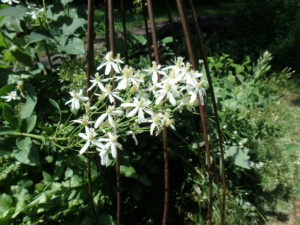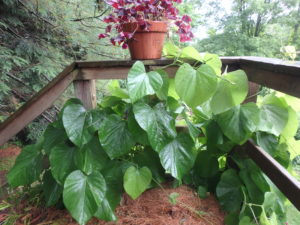Vines Worth Growing
As a boy I was fascinated by the idea that Tarzan the Ape Man could move through the jungle above the forest floor by swinging from vine to vine. I doubt that I ever saw a real Tarzan movie, but my imagination was good. I knew I wanted that ability to swing from vines. Now I just grow them. Let’s look at a few so you can decide if you’d like to plant one this summer.
Wisteria is a vine loved by many, particularly gardeners who have moved to New England from warmer parts of the country where it thrives. For decades, wisteria was a frustration for northern gardeners: it would grow nice green vines, but never blossom. That was because it set buds one summer for blooms the next spring. It bloomed before growing leaves and shoots. Our winters in the North Country killed the buds.
Then two new varieties appeared on the market: ‘Blue Moon’ and ‘Amethyst Falls’. Both are hardy to Zone 4 (minus 30 in winter) and bloom on new shoots that appear each spring. Mine bloom in late June or early July for about 3 weeks. The scent of Amethyst Falls I do not find pleasant (overtones of cat?), but the blossoms are smaller than those on Blue Moon and seem to last longer. I grow it on a cedar trellis that serves as an entrance to my vegetable garden.
The soil for my wisterias is rich, dark, and moist; they will grow anywhere, I think, given at least half a day of sun. The more sun, the more blossoms. I have heard from friends in southern New England that wisteria can be a pest because birds eat the seeds and spread them around, starting them at the edge of the woods. That has not happened for me.
Clematis is another great vine. I have 5 different kinds of clematis, and fully intend to buy another this summer – I just saw a great one while on a recent garden tour. That one, I learned from garden designer Cyndy Fine of Westminster, VT, is a Clematis viticella called ‘Betty Corning’. It blooms most of the summer and into the fall. It is has nodding bell-shaped flowers that are lavender to blue. Hardy to Zone 3 (minus 40 degrees).
The most vigorous, reliable of my clematis in one called Clematis jackmanii. It has nice purple blossoms and grows up wires I have attached to the front of my house. It easily grows 10 to 12-feet tall, and blooms enthusiastically most of July.
Then I have one called Clematis recta. Unlike most of the others, it does not climb up a trellis, but flops on the ground unless supported by something solid – a fence of some sort that can contain it. It blossoms appear in huge clusters of small white blossoms, followed by delicate airy seed heads. It dies back to the ground each winter. But each year it gets bigger and more bodacious.
All clematis want essentially the same thing: hot tops and cool feet. Plant perennials in front of your clematis to shade and cool the roots, but provide plenty of hot sun for the vines. They like rich soil, and plenty of moisture.
Then there is an amazing vine form of hydrangea: Hydrangea anomala ssp. petiolaris. This will attach itself to brick or stone with holdfasts, as opposed to twining vines like wisteria and most clematis. I have it on the north side of my barn as it grows well and blooms without much need for sunshine.
I originally used plastic ties to attach my climbing hydrangea to the barn, as its “feet” won’t grab wood. Now it has sent shoots in between the rough barn boards and it no longer needs support. It sends out “arms” 3 to 4 feet from the barn, each loaded with large white flower panicles that seem to defy gravity. Even in winter it is gorgeous.
Dutchman’s pipe (Aristolochia macrophylla) is another vine I grow that is very adaptable. It will grow in crummy soil in sun to shade, but does not want to be terribly dry. It has huge leaves, and small white blossoms reminiscent of little ivory pipes. Once established, it would be impossible to pull out. I have it growing on the north side of my deck, and it climbs up and tries to twine around potted plants growing on the rail. It completely hides the mess beneath the deck!
As for Tarzan, only wild grapes would do for his exploits. These are pests sometimes in the forest, as they can climb up trees and choke out nice trees. When I see that they are a problem, I cut them off at the base with roots loppers – a quick and easy, but temporary solution. But the birds do love the fruit when it is ripe, so I often do nothing about them.
Henry is the author of 4 gardening books. His web site is www.Gardening-Guy.com. See extra photos for his newspaper articles at https://dailyuv.com/






